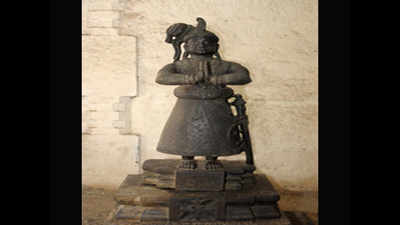- News
- City News
- bengaluru News
- Mysuru Dasara was first recorded in 1647
Trending
This story is from October 2, 2019
Mysuru Dasara was first recorded in 1647

Kanteerava statue (Pic: Archaeological Survey of India)
MYSURU: The year 1610, under the Wadiyar rule, is believed to have witnessed the first Navratri celebrations similar to what we see today. Historians assert that then ruler Raja Wadiyar passed a royal decree that Dasara celebrations must be done in a grand fashion by his successors every year without fail.
Raja Wadiyar’s heirs followed his footsteps in celebrating Mata Chamundeshwari and organising the 10-day events.The manuscript of 17th century court poet Govinda Vaidya meticulously recorded Navratri celebrations of 1647 in Srirangapatna under Narasaraja Wodeyar, well known as Ranadheera Kanteerava, who ruled from 1638 to 1659.
First known recording
Vaidya’s Kannada manuscript on palm leaves titled ‘Kanteeravanarsaraja Vijaya’, considered the first recording of Dasara celebrations of the Mysore kingdom, was discovered and researched by the Oriental Research Institute, Mysuru under the guidance of R Shama Sastry. He went on to pen a book about it in 1961.
Thousands of street lamps lined the streets and shone like the navratnas. All houses were decorated like a chitrashala and perfumes made of herbs were sprayed on streets as per a royal order to make thousands of visitors feel special. Four kalasas crafted out of pure gold for the festival were installed.
Diverse presence
The manuscripts notes that people and representatives of rulers from Tuludesa, Kodagu, Konkana, Malayalam, Thanjavur and Madurai and also Muslims came for the festivities with gifts including gold, elephants and horses for Kanteerava. Women from the group referred to as Nalinakshiyaru (with beautiful eyes) participated in the final-day procession of the Maharaja on his elephant.
Vaidya also records the colourful presence of devdasis and male prostitutes who were crowd-pullers and said they were in fine silk. There were also men dressed as women and their jewellery was stunning. A catwalk like event was celebrated on the streets by the women, men and cross-dressers.
Wrestling, animal combat
He also records that the festivities included Indrajalas (magic shows), poetry, painting events and stand-up comedy shows. But the crowd-pullers were the cockfight, bullfight and the Vajra mushti kalaga or the diamond wrestling in which wrestlers fought with a diamond-studded weapon and the man who bled after being hit was declared the loser. A symbolic version of this is fought even today as part of Dasara events.
Historians believe that Vaidya’s manuscript describes events in full glory day after day till the jumbo savari. A few paintings in the Ranganathaswamy Temple and Lakshmi Narasimha Temple in Srirangapatna record Dasara events but they were damaged over time.
(With inputs from N Mahadeva Swamy, researcher on Wadiyar dynasty and principal of JSS College of Arts and Commerce, Gundlupet)
Raja Wadiyar’s heirs followed his footsteps in celebrating Mata Chamundeshwari and organising the 10-day events.The manuscript of 17th century court poet Govinda Vaidya meticulously recorded Navratri celebrations of 1647 in Srirangapatna under Narasaraja Wodeyar, well known as Ranadheera Kanteerava, who ruled from 1638 to 1659.
First known recording
Vaidya’s Kannada manuscript on palm leaves titled ‘Kanteeravanarsaraja Vijaya’, considered the first recording of Dasara celebrations of the Mysore kingdom, was discovered and researched by the Oriental Research Institute, Mysuru under the guidance of R Shama Sastry. He went on to pen a book about it in 1961.
The court poet dedicated a chapter titled Purasingara (beautification of the city) to narrate Dasara celebrations in which he describes Srirangapatna looked like Brammalokam.
Thousands of street lamps lined the streets and shone like the navratnas. All houses were decorated like a chitrashala and perfumes made of herbs were sprayed on streets as per a royal order to make thousands of visitors feel special. Four kalasas crafted out of pure gold for the festival were installed.
Diverse presence
The manuscripts notes that people and representatives of rulers from Tuludesa, Kodagu, Konkana, Malayalam, Thanjavur and Madurai and also Muslims came for the festivities with gifts including gold, elephants and horses for Kanteerava. Women from the group referred to as Nalinakshiyaru (with beautiful eyes) participated in the final-day procession of the Maharaja on his elephant.
Vaidya also records the colourful presence of devdasis and male prostitutes who were crowd-pullers and said they were in fine silk. There were also men dressed as women and their jewellery was stunning. A catwalk like event was celebrated on the streets by the women, men and cross-dressers.
Wrestling, animal combat
He also records that the festivities included Indrajalas (magic shows), poetry, painting events and stand-up comedy shows. But the crowd-pullers were the cockfight, bullfight and the Vajra mushti kalaga or the diamond wrestling in which wrestlers fought with a diamond-studded weapon and the man who bled after being hit was declared the loser. A symbolic version of this is fought even today as part of Dasara events.
Historians believe that Vaidya’s manuscript describes events in full glory day after day till the jumbo savari. A few paintings in the Ranganathaswamy Temple and Lakshmi Narasimha Temple in Srirangapatna record Dasara events but they were damaged over time.
(With inputs from N Mahadeva Swamy, researcher on Wadiyar dynasty and principal of JSS College of Arts and Commerce, Gundlupet)
End of Article
FOLLOW US ON SOCIAL MEDIA










